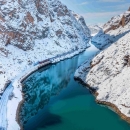

Where The Locals Go In Sofia
Sofia, the capital of Bulgaria — and its largest city — lies in the beating heart of the southern Balkans, with connections to Romania, Greece, Serbia, Turkey and North Macedonia. The Bulgarian city has a deep history and a rich culture, ensconced in its orthodox churches, Ottoman mosques, museums, galleries, and 2000-year-old Roman ruins (from when the city was called ‘Serdica’). Alongside the impressive heritage of the city’s built infrastructure, Sofia also boasts huge parks and a proximity to nature. Sofia is full of overlooked wonders, so let these tips by Sofia’s locals give you a glimpse into what you really shouldn’t miss on a visit to the city!
How to get to Sofia by train: Sofia is accessible by train from other major Bulgarian cities – Plovdiv is about 2.5 hours away, Burgas is 5.5 hours away and Varna is 7.5 hours away. Visit Bulgaria by rail with an Interrail Bulgaria Pass and the rest of Europe with a Global Pass.
An unmissable restaurant on a popular street

In the area around Sofia’s popular Shishman street, where many hip establishments seem to be popping up, Made in Blue is nearly impossible to miss: The restaurant/bar is located in an old, two-story building that is completely painted in blue from the outside (making the name quite fitting, too!).
It’s a go-to if you want to experiment with an unusual menu, which includes dishes such as hummus with veal and tripe, veal tongue with teriyaki and radishes, curry mussels with coconut, salad with cherries, sheep cheese and corn bread, and beyond. Made in Blue truly offers you a chance to experience Bulgaria’s changing cultural landscape through its delicious food.
The city’s healing springs

One of Sofia’s best kept secrets is its mineral water. This is surprising to travellers, because there are taps all over the city, where locals go with huge bottles to gather the (surprisingly) warm, sulfur-y, therapeutic water… completely for free! Legend has it that Sofia’s water could “cure anything but a broken heart” – you can give it a try and decide for yourself if that is true. The most famous tap is in the centre of the city, next to the Central Public Bathhouse. Once you’ve filled up your bottle, pay a visit to the old bathhouse, which today serves as the Sofia History Museum.
A reading room in the garden

If you’re visiting Sofia in the summer, take a seat at the lively City Garden and enjoy a warm night surrounded by majestic buildings such as the National Gallery and the National Theatre. Here’s a little secret: the tourist information pavilion in the middle of the gardens doubles up as a reading room (or “Chitalnya”), where you can leave and take books as you please. Even if you can’t read Bulgarian, it’s an ideal spot to meet fellow readers and make some progress on your own book!
An inconspicuous spot for world currency

Looking for a good euro/leva exchange deal? Look no further, as Nikar is likely to have an attractive exchange rate in the city. But this spot is much more than your average currency exchange. The owner takes pride in keeping stock of almost every currency available from everywhere in the world – which is very useful if you’re travelling around Europe by train, don’t you think?
A traditional Bulgarian grill in the park

If you’re in the mood for a traditional yet simple Bulgarian meal, grilled food is a great option. Drop in to Skara Bar for Bulgarian meatballs (kyufte) with fries and salad, comfort food for many locals. They also make a killer lyutenitsa (the secret is in the cinnamon!). The restaurant is located in Zaimov Park, which makes eating at this establishment feel like having a barbeque in the open. Boyko Blagoev, a local in Sofia, recommends finishing off the meal with some mint ice cream or pumpkin with walnuts, honey, and cinnamon.
Eclectic Bulgarian art at a cosy coffee shop

In the very heart of Sofia, at the end of old, quiet Marin Drinov street, sits +Tova. With its quaint interiors and abundant natural light, this little neighbourhood coffee shop is a wonderful place for you to relax and take a breath. Pick out a book from the vast collection on their sturdy, wooden stands, and if you’re looking for a small snack while you’re there, local Veronika recommends trying the oat milk latte and French quiche.
For those of you who would like to do a little more than unwind and read, +Tova also functions as an art gallery! Specifically showcasing Bulgarian artists, its assorted collection ranges from children’s books to ceramics and home décor, giving you an enriching glimpse into Bulgaria’s artistic imagination.
Upcycling HQ

“Reduce, reuse, recycle” goes the motto, and isn’t it great if you can upcycle what is otherwise considered trash into something useful, pretty, and culturally significant? Zona Urbana on Sofia’s Angel Kanchev Street does exactly this. Here, you will find bags, wallets, jewellery, and other wares and accessories made using old vinyl records, Communist newspapers, computer hardware, music notation, and more.
With a visit to Zona Urbana, you can bring back a piece of local Bulgarian history wrapped up in a trendy gift. Zona Urbana also offers a free souvenir when you visit: a cartoon map of Sofia with all its highlights!
A medieval art history monument

There is no dearth of impressive temples and churches in Sofia, but the Boyana Church in the outskirts of the city is a testament to the remarkable contribution that Bulgarian monumental paintings have made to European culture in medieval times, making it a must-visit if you want to gain insight into Bulgarian history.
Fittingly, the Boyana Church has been declared a UNESCO World Heritage monument in 1979. Be prepared to be mesmerised by the magnificent frescoes, especially the one depicting Sebastocrator Kaloyan and his wife, Desislava, the commissioners of the second section of the church. Local Yana recommends taking the guided tour, which will give you details about the masters of the frescoes as well as the people they represent. When you’re there, don’t forget to take a walk around the church, and as you do, notice the uncharacteristic but lovely red sequoia trees in the yard.
For more local favorites across Europe, check out Spotted by Locals.
You might like this as well:
-
![header-poland-gdansk-golden-gate-long-market-old-town]() Top 5 overlooked destinations in Europe Want to find lesser-known destinations in Europe? You can easily reach these hidden gems by rail with an Interrail or Eurail Pass.
Top 5 overlooked destinations in Europe Want to find lesser-known destinations in Europe? You can easily reach these hidden gems by rail with an Interrail or Eurail Pass. -
![backpack-backpacker-gap-year-youth-masthead]() Interrail vs regular train tickets Ready to unlock Europe by rail? Got a headache researching whether to buy a rail Pass or regular train tickets? Look no further to decide whether it’s worth booking Interrail or Eurail in 2023.
Interrail vs regular train tickets Ready to unlock Europe by rail? Got a headache researching whether to buy a rail Pass or regular train tickets? Look no further to decide whether it’s worth booking Interrail or Eurail in 2023.
Change of currency
You cannot change the currency once you have a Pass in your cart. Remove the Pass, and then change the currency on the website header.







